Identification and Analysis of Sets Variables for of Municipal Waste Management Modelling
Abstract
1. Introduction
- (a)
- Socioeconomic factors, including the level of economic development and income of residents;
- (b)
- The size of the municipality, the structure of use, the level of urbanization, and the density of population;
- (c)
- The type of waste collection system and the level of ecological awareness of the local community.
2. Materials and Methods
- C1—municipality administrative type (where: 1—municipality, 2—commune, and 3—rural municipality);
- C2—functional structure of communes (where: 1—urban, 2—urbanized area, 3—multi-functional transition area, 4—mainly agricultural area, 5—area with prevailing agricultural function, 6—area with tourist and recreational functions, 7—forest functions area, and 8—mixed functions area);
- C3—population density per·km−2;
- C4—building age rate defined as a weighted average of the age of all buildings in the municipality;
- C5—indicator household size, as persons per household (per building−1);
- C6—average agricultural area ha;
- C7—percentage of buildings heated with natural gas;
- C8—participation of farms which earn income from agricultural activity;
- C9—indicator of the municipality income as participation in taxes from natural persons per one citizen of the municipality (PLN·per−1);
- C10—typology of municipalities according to the scope of impact (where: 1—zone of the strongest real impact (real suburbs zone); 2—zone of the strongest possible impact (possible suburbs zone); 3—weakly available zone of strong impact; 4—zone of weak possible impact (possible internal zone); 5—outskirts zone; and 6—urban centers cores);
- w—voivodeship.
- Universal character—features should have a recognized significance and meaning;
- Variabilities—properties should not be similar to each other with regard to information on facilities (high ability of discrimination is in case of features with great variability);
- Importance—important properties are those which achieve high values with difficulties.
- (a)
- Properties xij are transformed according to the following formula:The property, thus, assumes values from the range [0,1].where Xij is the j-th feature of the i-th commune, n is the number of communes, and m is the number of features.
- (b)
- Transformed property values are ordered increasingly, and the median Mej, is determined;
- (c)
- The indicator tj is determined by the following:where j equals 1, 2, …, m. The w ij is calculated as follows:
3. Results and Discussion
3.1. Description of Variability of the Produced Waste Amount
3.2. Modelling the Waste Accumulation Index
4. Conclusions
- The developed model is a versatile solution that may apply to the analysis of regions in Poland and other countries. The use of a new indicator (a functional type of a commune) is important, which confirmed its use in all input data to models. In our further research, we are using developed models on data from other regions.
- Based on the selected independent variables which met the criteria of universality, variability, and significance, prognostic models of the mass waste accumulation indicator were constructed with the use of artificial neural networks (ANN), multivariate adaptive regression splines (MARS), classification and regression tree (CART), chi-square automatic interaction detector (CHAID), support regression trees (SRT), and support vectors (SV). Prediction errors of the mass waste accumulation indicator did not indicate which of the analyzed methods enables the obtainment of predictions of the best quality, since the value of the error MAPE was at the level of 25%, regardless the applied method.
- The development of a new model for homogeneous groups determined on the basis of cluster analysis from the adopted explanatory variables helped improve the forecast. The effect of this action was to reduce the forecast error to 21%–22% for the test set.
Author Contributions
Funding
Acknowledgments
Conflicts of Interest
References
- Bach, H.; Mild, A.; Natter, M.; Weber, A. Combining socio-demographic and logistic factors to explain the generation and collection of waste paper. Resour. Conserv. Recycl. 2004, 41, 65–73. [Google Scholar] [CrossRef]
- Beigl, P.; Lebersorger, S.; Salhofer, S. Modelling municipal solid waste generation: A review. Waste Manag. 2008, 28, 200–214. [Google Scholar] [CrossRef] [PubMed]
- Hage, O.; Söderholm, P. An econometric analysis of regional differences in household waste collection: The case of plastic packaging waste in Sweden. Waste Manag. 2008, 28, 1720–1731. [Google Scholar] [CrossRef] [PubMed]
- Hockett, D.; Lober, D.J.; Pilgrim, K. Determinants of Per Capita Municipal Solid Waste Generation in the Southeastern United States. J. Environ. Manag. 1995, 45, 205–217. [Google Scholar] [CrossRef]
- Lebersorger, S.; Beigl, P. Municipal solid waste generation in municipalities: Quantifying impacts of household structure, commercial waste and domestic fuel. Waste Manag. 2011, 31, 1907–1915. [Google Scholar] [CrossRef] [PubMed]
- Miller, I.; Lauzon, A.; Wattle, B.; Ritter, M.; Hood, J. Determinants of Municipal Solid Waste Generation and Recycling in Western New York Communities. J. Solid Waste Technol. Manag. 2009, 35, 209–236. [Google Scholar] [CrossRef]
- Passarini, F.; Vassura, I.; Monti, F.; Morselli, L.; Villani, B. Indicators of waste management efficiency related to different territorial conditions. Waste Manag. 2011, 31, 785–792. [Google Scholar] [CrossRef]
- Szul, T.; Nęcka, K. Methods of Estimating Waste Accumulation Rate in Rural Areas of the Lubelskie Voivodship. Barom. Reg. 2016, 14, 165–171. [Google Scholar]
- Purcell, M.; Magette, W. Prediction of household and commercial BMW generation according to socio-economic and other factors for the Dublin region. Waste Manag. 2009, 29, 1237–1250. [Google Scholar] [CrossRef]
- Agnieszka, B.B.; Maja, R.; Dana, A.; Jan, Z.; Magdalena, D.V. Assessment Strategies for Municipal Selective Waste Collection—Regional Waste Management. J. Ecol. Eng. 2018, 19, 33–41. [Google Scholar]
- Daskalopoulos, E.; Badr, O.; Probert, S. Municipal solid waste: a prediction methodology for the generation rate and composition in the European Union countries and the United States of America. Resour. Conserv. Recycl. 1998, 24, 155–166. [Google Scholar] [CrossRef]
- Massimiliano, M.; Roberto, Z. Waste generation, waste disposal and policy effectiveness: Evidence on decoupling from the European Union. Resour Conserv Recycl. 2008, 52, 1221–1234. [Google Scholar]
- Vieira, V.H.A.D.M.; Matheus, D.R. The impact of socioeconomic factors on municipal solid waste generation in São Paulo, Brazil. Waste Manag. Res. 2017, 36, 79–85. [Google Scholar] [CrossRef] [PubMed]
- Adamcova, D.; Vaverková, M.; Stejskal, B.; Břoušková, E. Household Solid Waste Composition Focusing on Hazardous Waste. Pol. J. Environ. Stud. 2016, 25, 487–493. [Google Scholar] [CrossRef]
- Suthar, S.; Singh, P. Household solid waste generation and composition in different family size and socio-economic groups: A case study. Sustain. Cities Soc. 2015, 14, 56–63. [Google Scholar] [CrossRef]
- Khan, D.; Kumar, A.; Samadder, S. Impact of socioeconomic status on municipal solid waste generation rate. Waste Manag. 2016, 49, 15–25. [Google Scholar] [CrossRef]
- KPGO Krajowy Plan Gospodarki Odpadami na lata 2006–2010. Available online: https://www.prawo.pl/akty/m-p-2006-90-946,17320015.html (accessed on 24 October 2019).
- KPGO Krajowy Plan Gospodarki Odpadami 2022. Available online: https://bip.mos.gov.pl/strategie-plany-programy/krajowy-plan-gospodarki-odpadami/krajowy-plan-gospodarki-odpadami-2022/ (accessed on 24 October 2019).
- Talalaj, I.A.; Walery, M. The effect of gender and age structure on municipal waste generation in Poland. Waste Manag. 2015, 40, 3–8. [Google Scholar] [CrossRef]
- Intharathirat, R.; Salam, P.A.; Kumar, S.; Untong, A. Forecasting of municipal solid waste quantity in a developing country using multivariate grey models. Waste Manag. 2015, 39, 3–14. [Google Scholar] [CrossRef]
- Keser, S.; Duzgun, S.; Aksoy, A. Application of spatial and non-spatial data analysis in determination of the factors that impact municipal solid waste generation rates in Turkey. Waste Manag. 2012, 32, 359–371. [Google Scholar] [CrossRef]
- Szul, T.; Knaga, J.; Nęcka, K. Application of Rough Set Theory to Establish the Amount of Waste in Households in Rural Areas. Ecol. Chem. Eng. S 2017, 24, 311–325. [Google Scholar] [CrossRef][Green Version]
- Emery, A.D.; Griffiths, A.J.; Williams, K.P. An in depth study of the effects of socio-economic conditions on household waste recycling practices. Waste Manag. Res. 2003, 21, 180–190. [Google Scholar] [CrossRef] [PubMed]
- Boer, E.D.; Jędrczak, A.; Kowalski, Z.; Kulczycka, J.; Szpadt, R. A review of municipal solid waste composition and quantities in Poland. Waste Manag. 2010, 30, 369–377. [Google Scholar] [CrossRef] [PubMed]
- A Handbook for Researchers and Practitioners. Available online: https://marketing.wharton.upenn.edu/files/?whdmsaction=public: main.file&fileID=794 (accessed on 28 June 2018).
- Azadi, S.; Karimi-Jashni, A. Verifying the performance of artificial neural network and multiple linear regression in predicting the mean seasonal municipal solid waste generation rate: A case study of Fars province, Iran. Waste Manag. 2016, 48, 14–23. [Google Scholar] [CrossRef] [PubMed]
- Maryam, A.; Ali, E.H. Forecasting municipal solid waste generation using artificial intelligence modelling approaches. Waste Manag. 2017, 56, 13–22. [Google Scholar]
- Ustawa z dnia 14 grudnia 2012 r. o odpadach. Dz.U. 2013 poz. 21. Available online: http://prawo.sejm.gov.pl/isap.nsf/DocDetails.xsp?id=wdu20130000021 (accessed on 10 December 2018).
- D’Obyrn, K.; Szalińska, E. Odpady Komunalne: Zbiórka, Recykling, Unieszkodliwianie Odpadów Komunalnych I Komunalnopodobnych: Podręcznik Dla Studentów Wyższych Szkół Technicznych; Politechniki Krakowskiej: Kraków, Poland, 2005. [Google Scholar]
- Statistics Poland. Central Statistical Office. Local Data Bank. 2017. Available online: https://bdl.stat.gov.pl/BDL/start (accessed on 15 May 2018).
- Współczesne typologie obszarów wiejskich w Polsce–przegląd podejść metodologicznych. Available online: http://www.rcin.org.pl/Content/51257/WA51_70537_r2014-t86-z4_Przeg-Geogr-Banski.pdf (accessed on 24 October 2019).
- Statystyczne Metody Analizy Danych. Available online: http://zsi.tech.us.edu.pl/~nowak/smad/index.html (accessed on 24 October 2019).
- Breiman, L.; Friedman, J.H.; Olshen, R.A.; Stone, C.J. Classification and Regression Trees; Chapman & Hall/Crc: London, UK; New York, NY, USA; Washington, DC, USA, 1984. [Google Scholar]
- Brain, D.R. Pattern Recognition and Neural Networks; Cambridge University Press: Cambridge, UK, 1996. [Google Scholar]
- Greedy Function Approximation, A Gradient Boosting Machine. Available online: https://www.google.com.hk/url?sa=t&rct=j&q=&esrc=s&source=web&cd=2&ved=2ahUKEwi1s7mO4bHlAhVqF6YKHVDPAYgQFjABegQIAhAC&url=https\%3A\%2F\%2Fstatweb.stanford.edu\%2F~jhf\%2Fftp\%2Ftrebst.pdf&usg=AOvVaw0rq6xVnWvQoQvX2dyZNOkP (accessed on 24 October 2019).
- Stochastic Gradient Boosting. Available online: https://www.google.com.hk/url?sa=t&rct=j&q=&esrc=s&source=web&cd=2&ved=2ahUKEwiAlou_4rHlAhXMUN4KHSZ8Af4QFjABegQIABAC&url=https%3A%2F%2Fstatweb.stanford.edu%2F~jhf%2Fftp%2Fstobst.pdf&usg=AOvVaw2pYbdrR1pH_WjsRPMM0sOy (accessed on 24 October 2019).
- Jerome, H.F. Multivariate adaptive regression splines (with discussion). Ann. Stat. 1991, 19, 1–141. [Google Scholar]
- Trevor, H.; Robert, T.; Jerome, F. The Elements of Statistical Learning: Data Mining, Inference, and Prediction; Springer: Berlin, Germany, 2001. [Google Scholar]
- McCulloch, W.S.; Pitts, W. A logical calculus of the ideas immanent in nervous activity. Bull. Math. Boil. 1943, 5, 115–133. [Google Scholar] [CrossRef]
- Paweł, D. Prognozowanie w Przedsiębiorstwie; Wolters Kluwer Polska Sp. Z o.o.: Kraków, Poland, 2008. [Google Scholar]
- Cieślak, M. Prognozowanie Gospodarcze; Wydawnictwo Naukowe PWN: Warszawa, Poland, 1999. [Google Scholar]
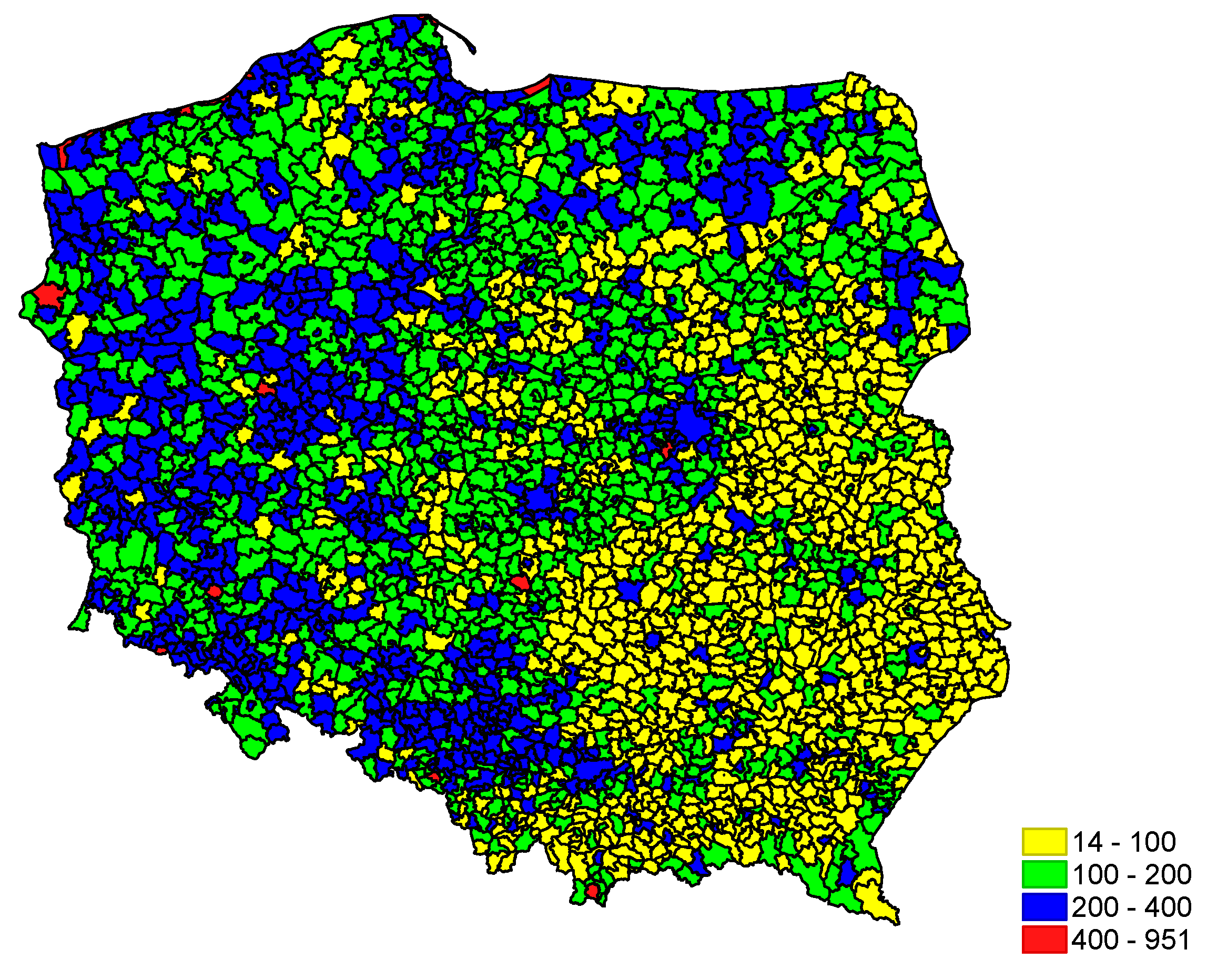
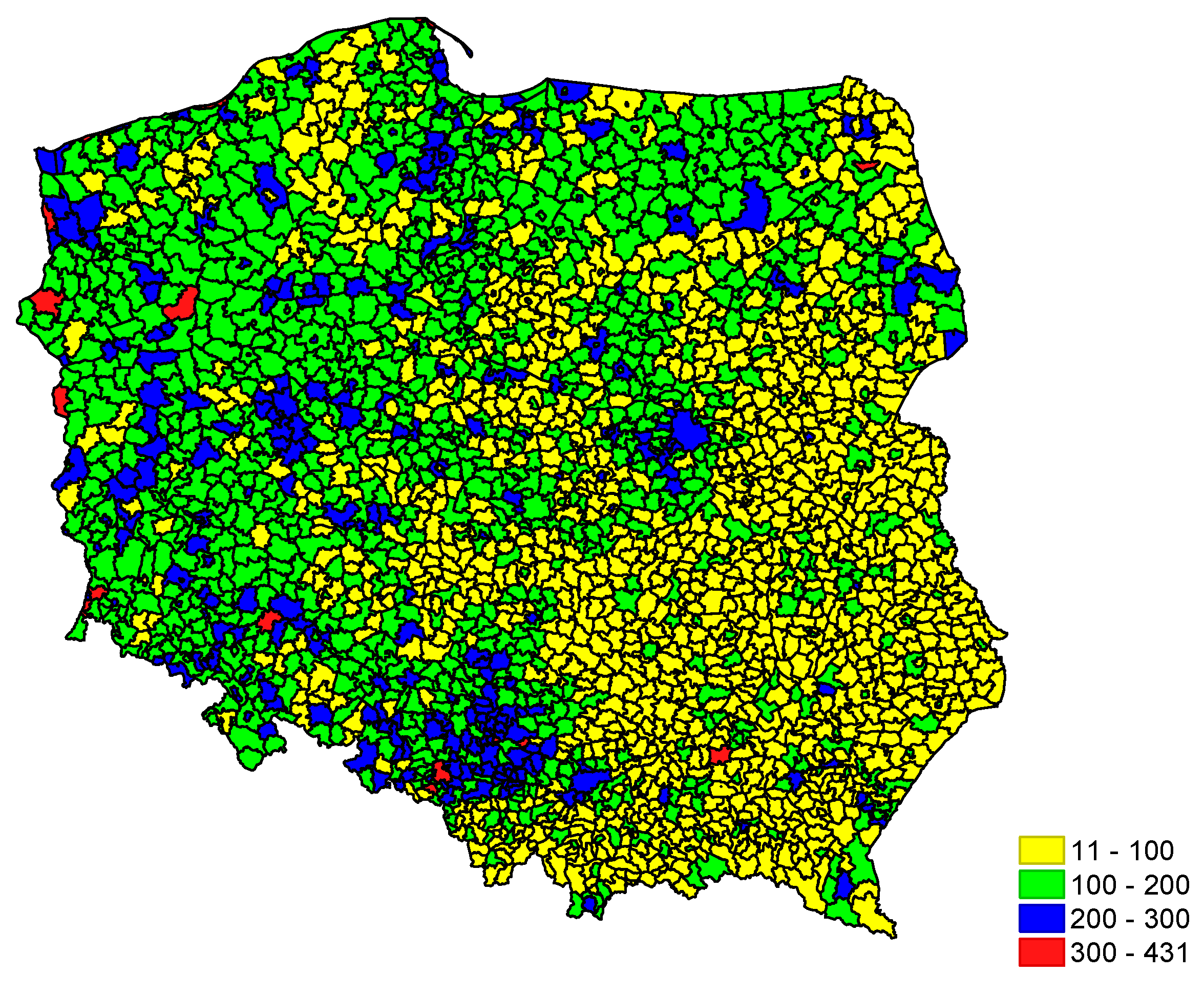
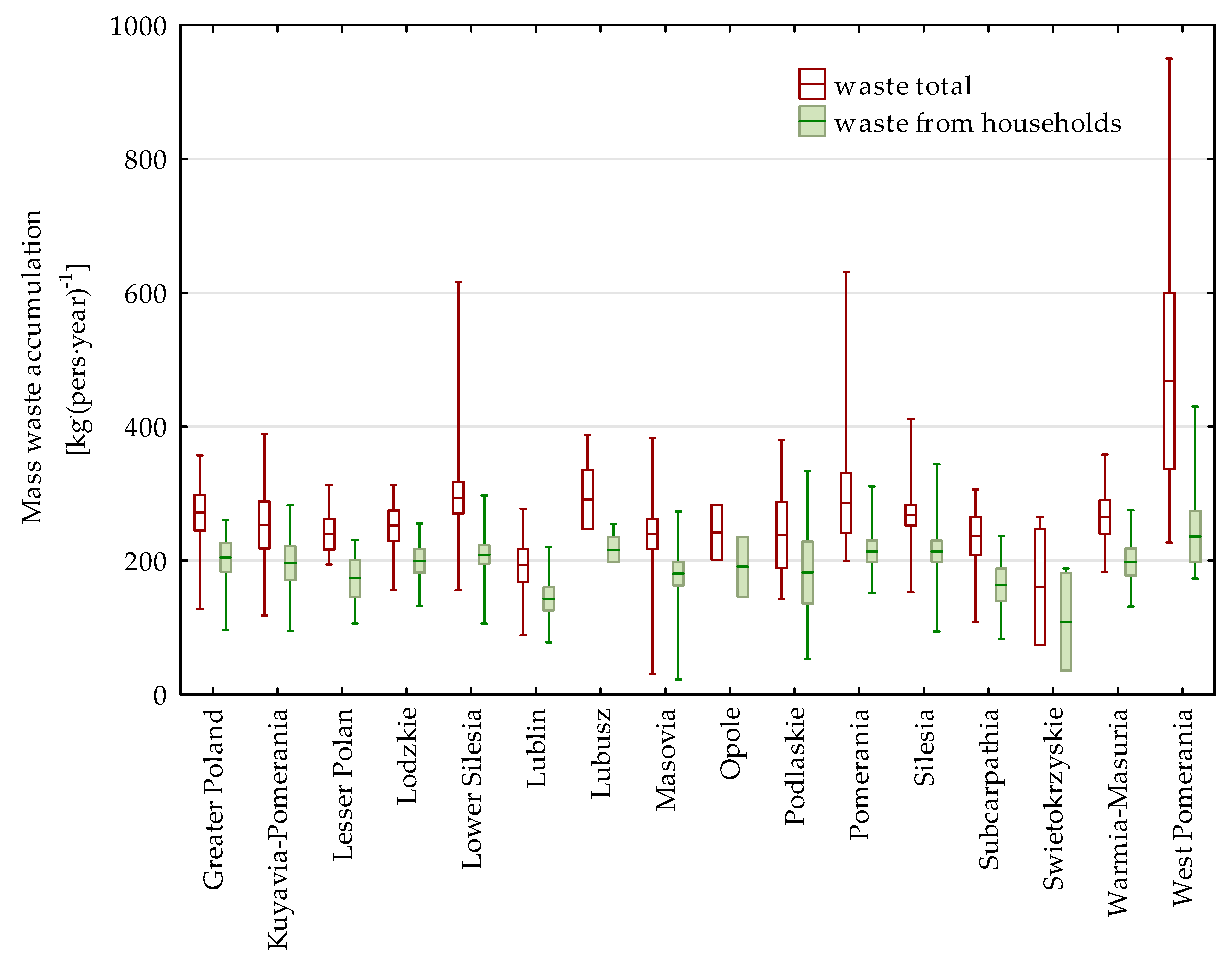
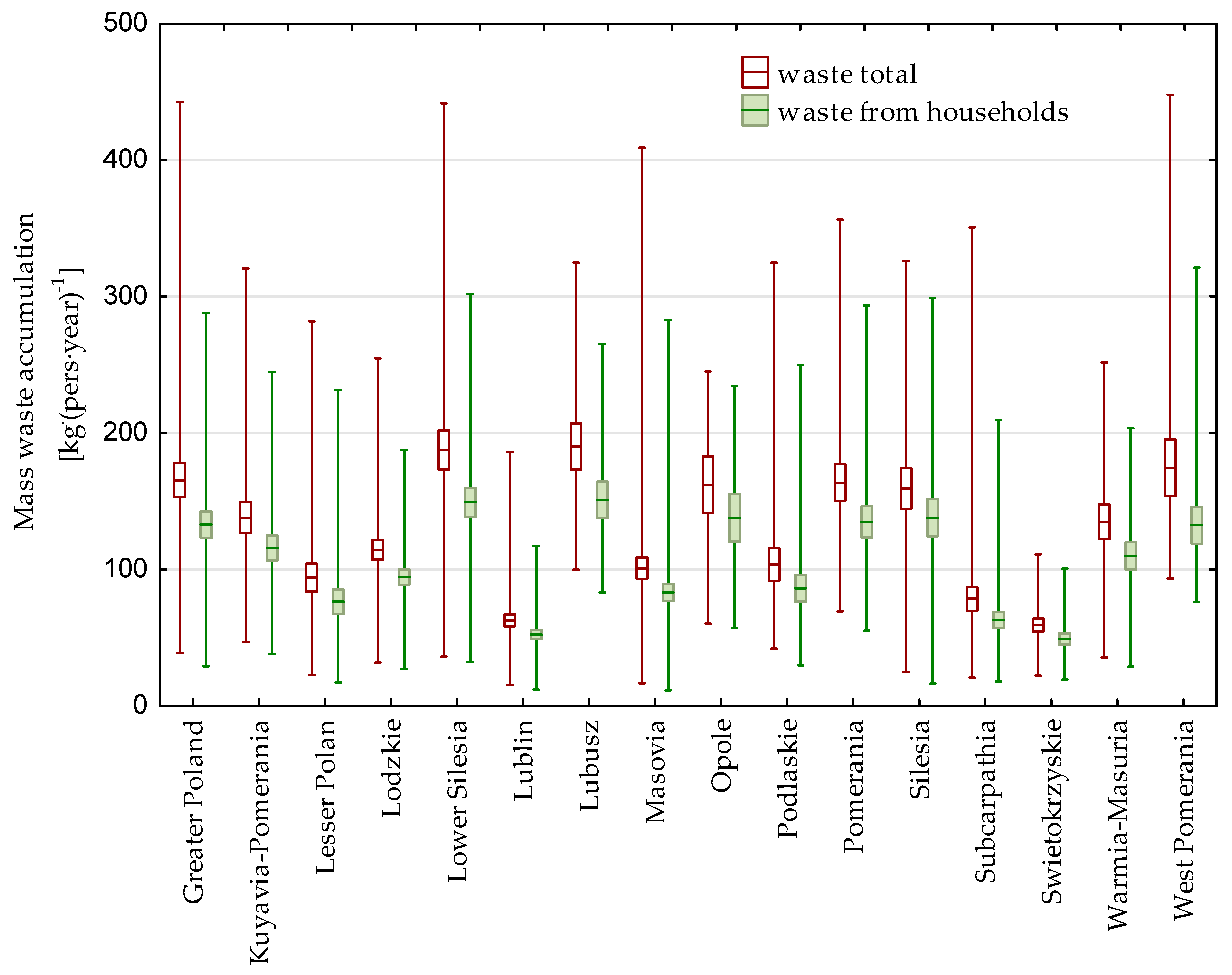
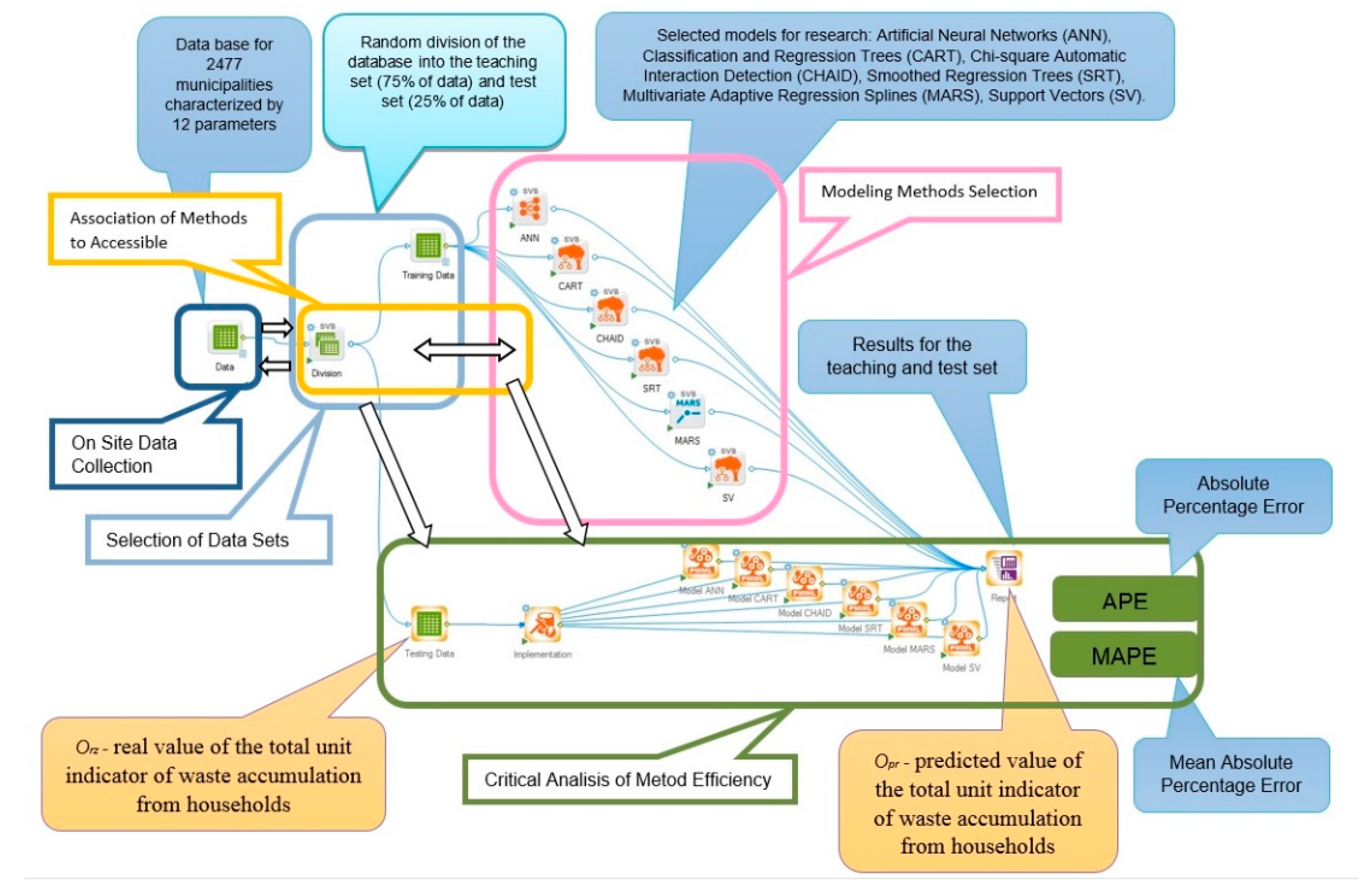
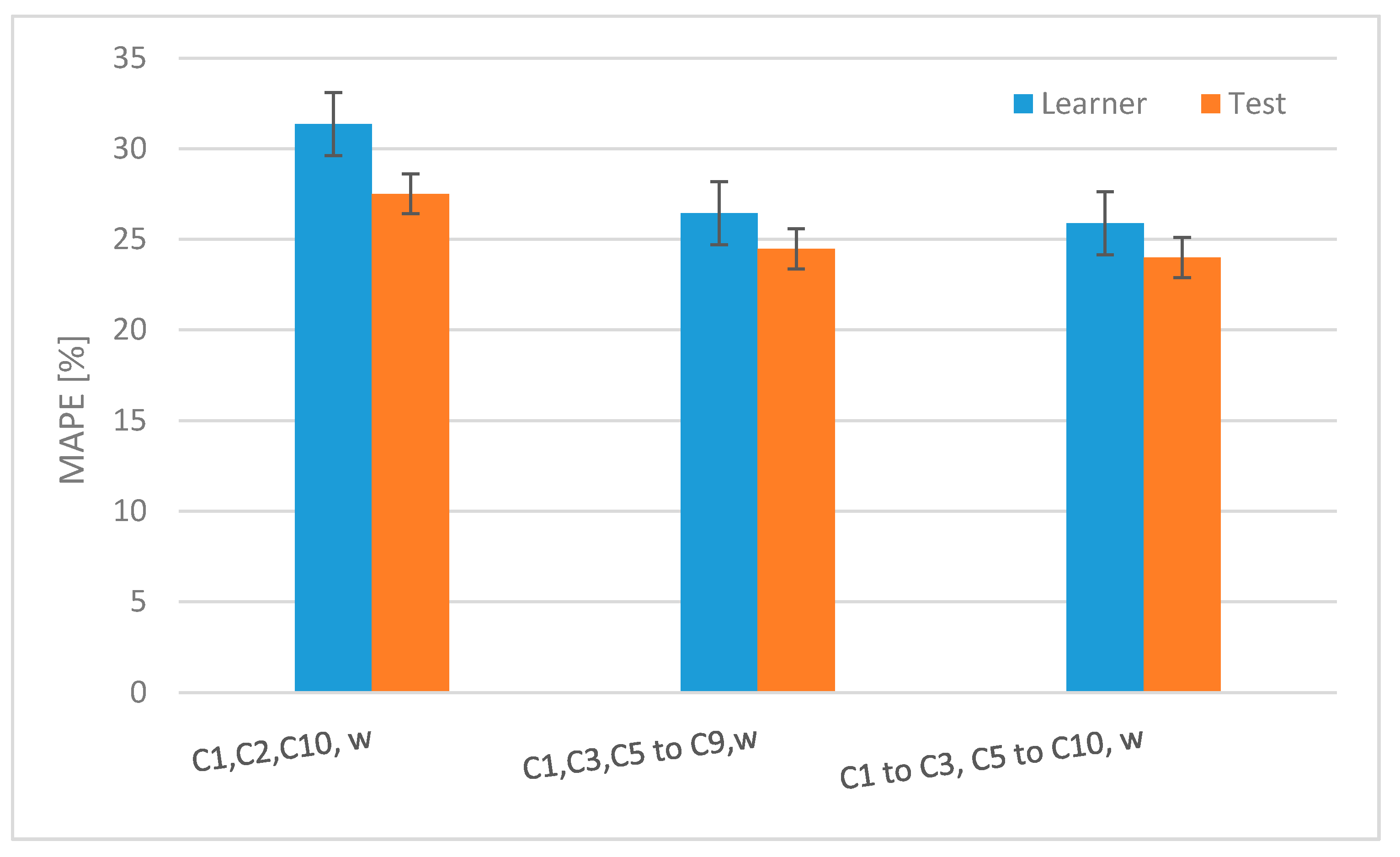
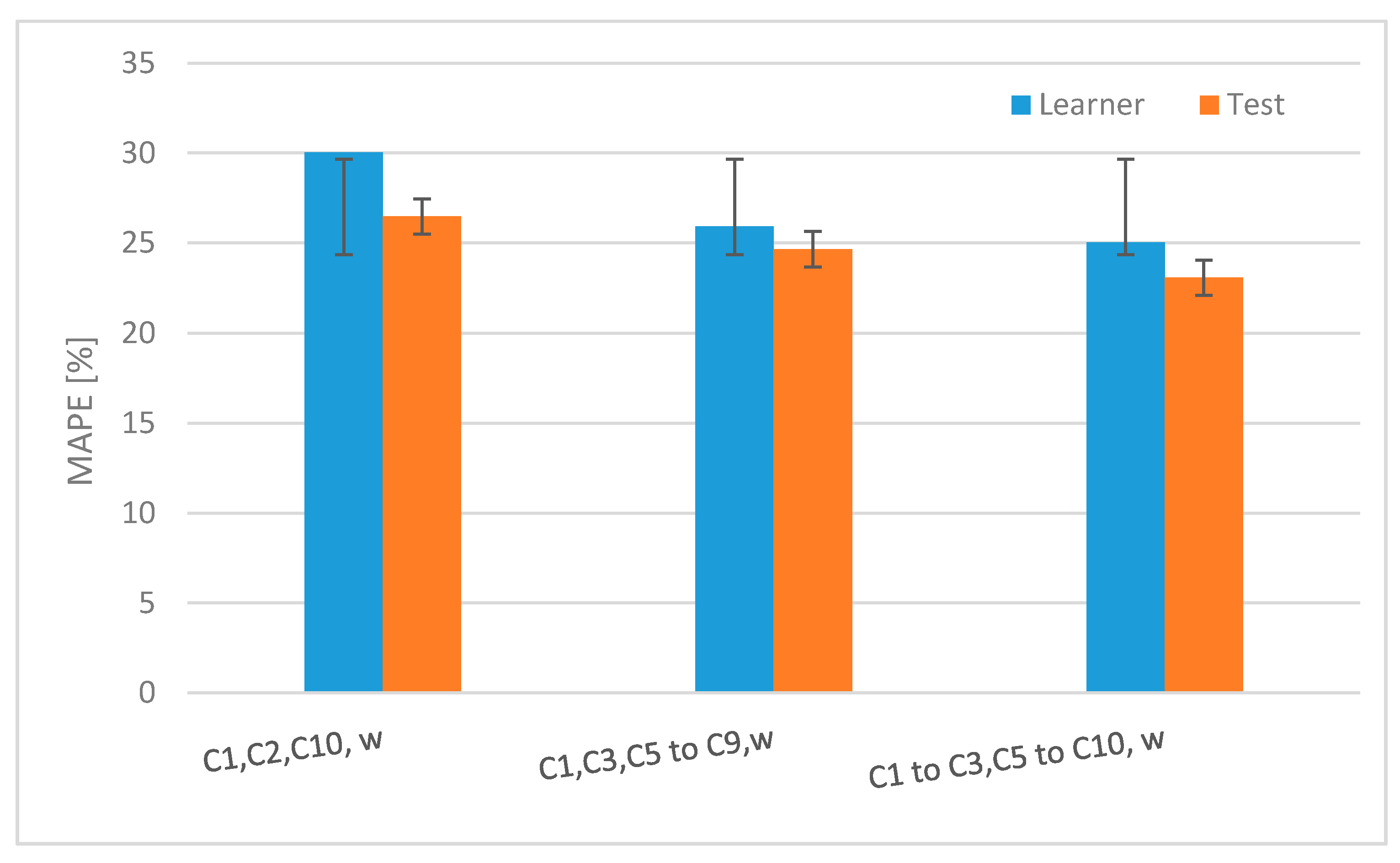

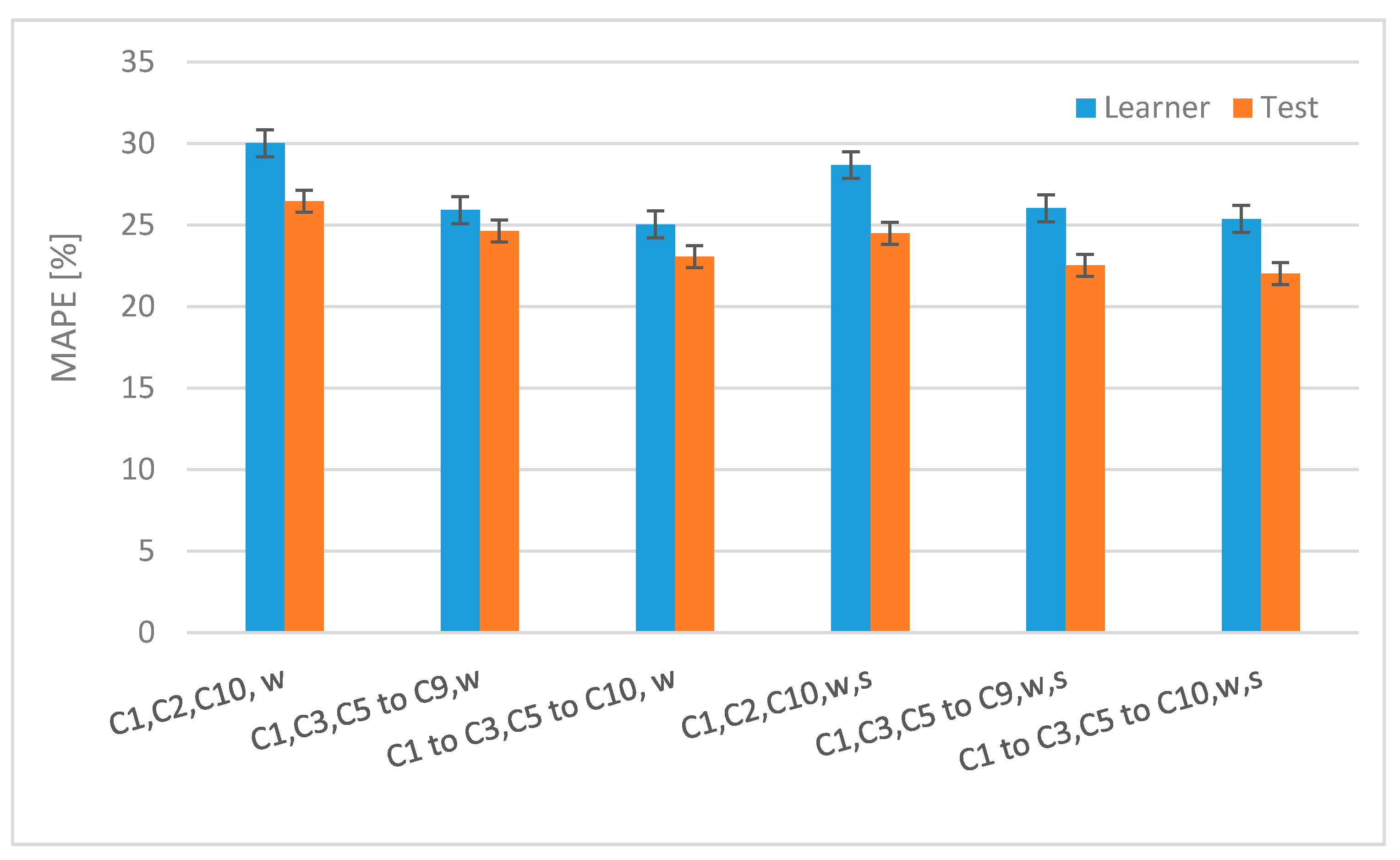
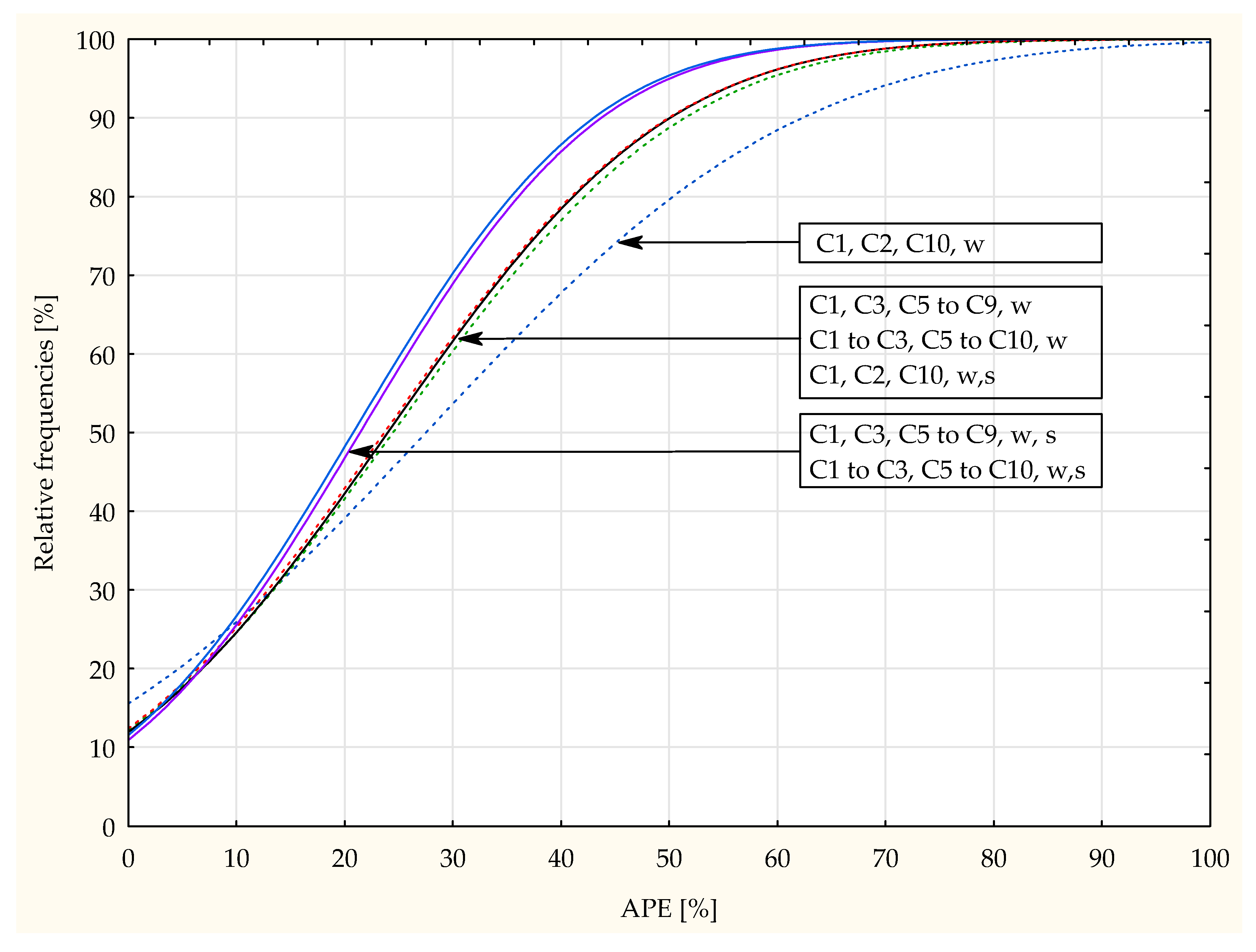
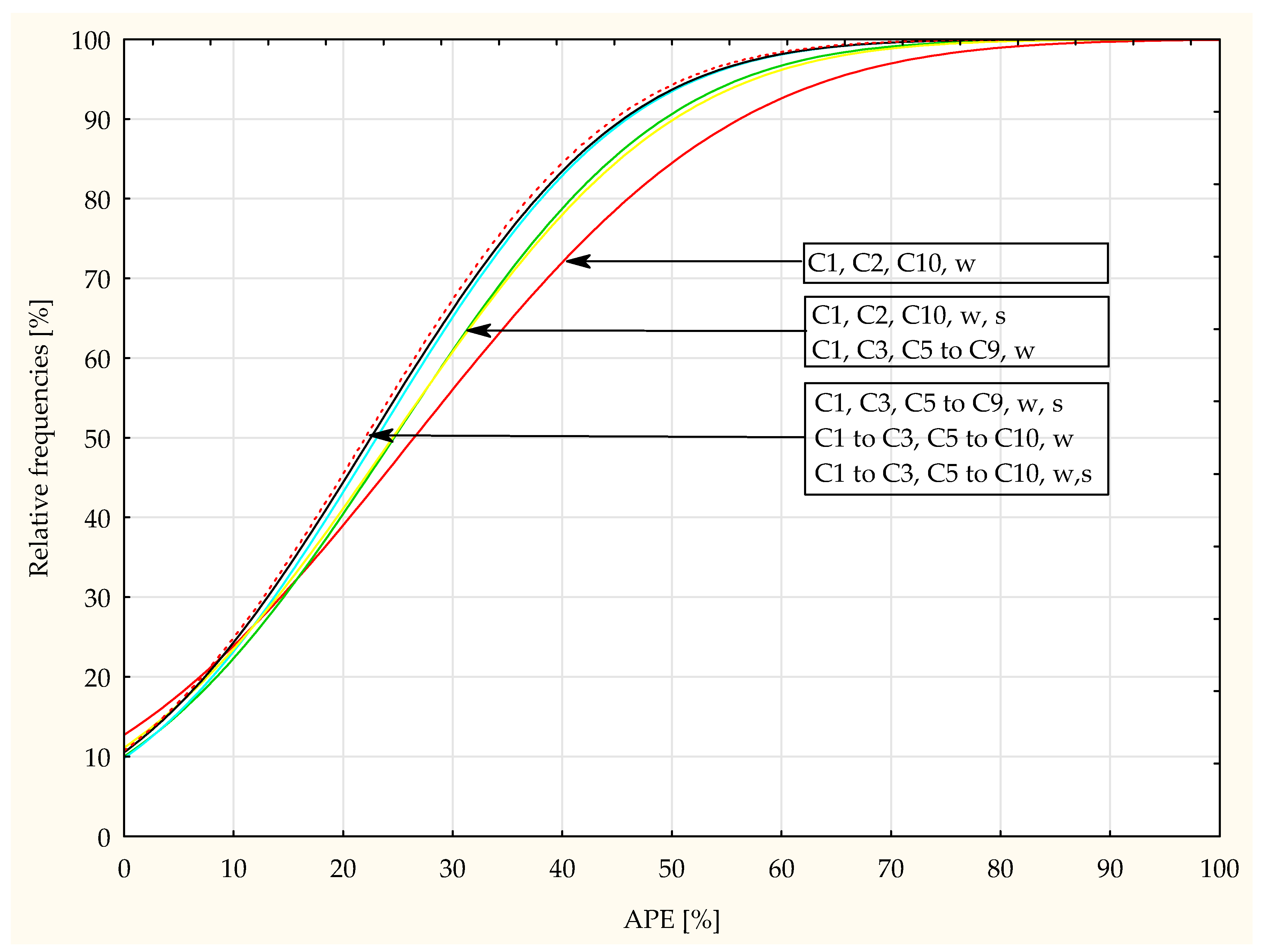
| Independent Variables: | Reference: |
|---|---|
| administrative, functional, and economic type of the municipality | [2] |
| affluence (“standard of living”) and inhabitants’ lifestyle | [15,16] |
| average size of a household | [5] |
| buildings type and heating system | [2,5,12] |
| climate factors (the temperature and precipitation) and the season of the year | [7,12,17,18] |
| eating habits and health indicators, such as lifespan and infant mortality, as well as the age structure of population | [17,19] |
| fees for waste collection and disposal calculated per one inhabitant or per one ton and the frequency of waste collection | [7,12] |
| household size | [2,5,15,20] |
| level of contamination in selectively collected waste | [7,12] |
| municipality’s income from taxes calculated per one inhabitant | [13,21,22] |
| other technical and sanitary equipment of buildings | [5] |
| participation in taxes comprising national budget income personal income tax | [5] |
| participation of ashes and/or biodegradable waste in the mixed municipal waste stream | [7,12] |
| participation of households composting organic waste | [7,12] |
| participation of households equipped with furnace for solid fuels | [5] |
| participation of waste collected selectively | [7,12] |
| participation of waste from infrastructural facilities in the total weight of municipal waste | [7,12] |
| percentage of municipality’s/city’s inhabitants covered under waste collection system | [7,12] |
| population density | [5,6,20,23] |
| saturation of technical infrastructure facilities | [2] |
| social factors | [2,5,6,13,19,23] |
| the number and capacity of containers calculated per one household—furnishing houses with small capacity containers motivates the inhabitants to collect waste selectively | [7,12] |
| the number of unemployed people, the level and structure of employment | [5,19,20] |
| tourism—the number of accommodation places, hotels, guesthouses, etc. | [17] |
| tradition and people’s habits | [6,17] |
| urbanization level | [2,4,20,23] |
| Specification | According to [29] [kg∙(per∙year)−1] | According to [17] [kg∙(per∙year)−1] |
|---|---|---|
| big cities (>100 thousand citizens) | 220–400 | 385.9 |
| small and average cities (10–50 thousand citizens) | 180–330 | 346.2 |
| rural areas | 90–110 | 233.9 |
| Waste | Value: | |||
|---|---|---|---|---|
| Average | Min. | Max. | Variability Coefficient [%] | |
| [kg·(per·year)−1] | ||||
| total 2005–2012 | 144.4 | 4.1 | 829.2 | 27.4 |
| total 2013–2016 | 162.1 | 30.9 | 950.5 | 53.0 |
| from households 2005–2012 | 105.5 | 1.6 | 438.3 | 30.0 |
| from households 2013–2016 | 128.4 | 26.1 | 430.1 | 47.6 |
| Waste: | Administrative Type of Commune/Municipality | Average | |||
|---|---|---|---|---|---|
| Value | Min | Max | Variability Coefficient [%] | ||
| [kg·(per·year)−1] | |||||
| total | municipal | 266.0 | 104.4 | 880.5 | 28.6 |
| commune | 130.9 | 30.9 | 950.5 | 56.3 | |
| rural municipality | 184.7 | 54.3 | 466.5 | 36.1 | |
| from households | Municipal | 197.8 | 82.9 | 385.2 | 24.6 |
| Rural | 106.7 | 26.1 | 430.1 | 49.6 | |
| rural municipality | 145.5 | 43.0 | 373.4 | 36.2 | |
| Variable | Cluster (s) | Average Value of the Waste Accumulation Indicator (kg·(per·year)−1) | Coefficient of Variability (%) |
|---|---|---|---|
| waste total | 1 | 83 ± 5 | 47 |
| 2 | 100 ± 9 | 52 | |
| 3 | 139 ± 12 | 45 | |
| 4 | 232 ± 15 | 25 | |
| waste from households | 1 | 69 ± 3 | 44 |
| 2 | 80 ± 7 | 52 | |
| 3 | 111 ± 9 | 47 | |
| 4 | 170 ± 13 | 29 |
© 2019 by the authors. Licensee MDPI, Basel, Switzerland. This article is an open access article distributed under the terms and conditions of the Creative Commons Attribution (CC BY) license (http://creativecommons.org/licenses/by/4.0/).
Share and Cite
Nęcka, K.; Szul, T.; Knaga, J. Identification and Analysis of Sets Variables for of Municipal Waste Management Modelling. Geosciences 2019, 9, 458. https://doi.org/10.3390/geosciences9110458
Nęcka K, Szul T, Knaga J. Identification and Analysis of Sets Variables for of Municipal Waste Management Modelling. Geosciences. 2019; 9(11):458. https://doi.org/10.3390/geosciences9110458
Chicago/Turabian StyleNęcka, Krzysztof, Tomasz Szul, and Jarosław Knaga. 2019. "Identification and Analysis of Sets Variables for of Municipal Waste Management Modelling" Geosciences 9, no. 11: 458. https://doi.org/10.3390/geosciences9110458
APA StyleNęcka, K., Szul, T., & Knaga, J. (2019). Identification and Analysis of Sets Variables for of Municipal Waste Management Modelling. Geosciences, 9(11), 458. https://doi.org/10.3390/geosciences9110458






